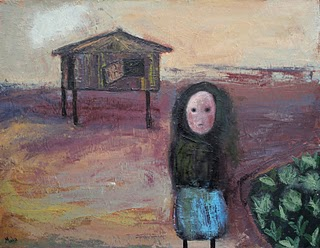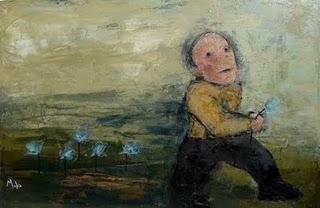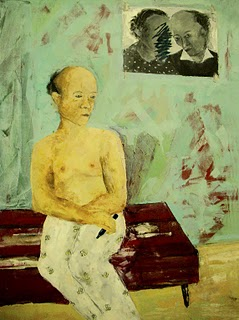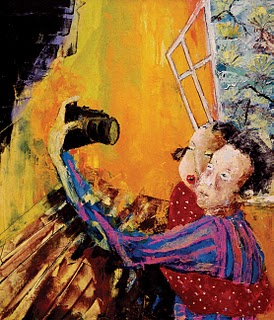The Picture as a Story
Michael Berman, UK
Michael Berman works as a teacher and a writer. Publications include The Power of Metaphor for Crown House, The Nature of Shamanism and the Shamanic Story for Cambridge Scholars Publishing, Shamanic Journeys through the Caucasus for O-Books, and All God’s Creatures: Stories Old and New for Pendraig Publishing. ELT publications include A Multiple Intelligences Road to an ELT Classroom, In a Faraway Land (a resource book for teachers on storytelling), and On Business and for Pleasure (a self-study workbook). For more information please visit www.Thestoryteller.org.uk .
E-mail: michaelberman@blueyonder.co.uk
Pictures can tell stories. Characters can step out of them and talk to us. What, for example, is the woman standing outside her home in the painting below saying to the person holding the camera or paintbrush? Working individually, in pairs or in groups, see if you can put her thoughts into words:
And this is my Home

Here is a sample text. How does it compare with yours?
“Yes. This is my home. Not a particularly inviting home perhaps and I suppose my eyes don’t exactly shine ‘Come in. You’re welcome’ either. But my home and my gaze reflect who I am. A person with a past, a person scarred, but a person who has stood up to all that life has thrown at her, overcome it somehow and survived. As for you, well you’ll just have to take me or leave me. I have long since stopped bothering to try to play the game, to make people like me. I have no need for that any more. However, if you do show yourself to be trustworthy and reliable, if you do prove to me you have good intent, then perhaps, perhaps, just maybe …”
Now imagine you're in a picture or photo, standing outside your home. What do you want to say to the person in front of you holding the camera or paintbrush? In direct speech, like the example presented above, write out the words:
In the same way as the story can be treated as a ceremony so can the picture - the introduction to the activity marks the severance stage when you leave the everyday world behind you, reflecting on the picture is a means of entering sacred time and space, and the change of focus to the learners' own personal experiences marks the reincorporation into everyday reality. Here are three more examples. The pictures are all of paintings by Maka Batiashvili, an artist from the Republic of Georgia.
(To see more of her work, please visit www.maka.batiashvili.net ).
The Gift

What would you give the person you love if you could? Write a poem to him / her:
If I could I’d __________ with __________
And I’d __________
Then I’d __________ like __________
That it’s all for you and nobody else – If.
And here is a sample poem. How does it compare with yours?
If I could I’d shower you with kisses like raindrops
I’d lay you on a bed of cherry blossom
With a pillow of petals for your head
I’d crown you with a circle of sunbeams
And hang daisy chains around your neck
Then I’d whisper like the wind through the leaves
That it’s all for you and nobody else – If.
What was the last present you actually gave to or received from someone you love? Or what is the present you’d most like to be given, and why? Tell the person sitting next to you about it.
Why is the woman in the picture on the wall of the prisoner’s cell crossed out? Working individually, in pairs or in groups, see if you can put the prisoner’s thoughts into words:
The Prisoner

And here is a sample text. How does it compare with yours?
“I read somewhere that the opposite emotion to love is not hate, as most people would expect it to be, but indifference. As you can see very clearly, though, that’s nowhere near where I am today, in this prison cell I’ve created for myself, but still misguidedly blame you for. And the only thought in my head is how to get my revenge, how to make sure you suffer the same way as I have done. And that’s what I pray for five times a day. If only this pencil I hold was a knife and that I could cut you out of my life, just like a surgeon skilfully cuts out a cancer! Instead all I can do is to torture myself with your memory. It’s become a way of life now this pain, and the truth is I’d be lost without it, for all there would be is a gaping void and nothing to fill it with. That’s me and where I am today – not an attractive proposition I have to admit, and someone to avoid like the plague, someone to steer well clear of.”
How do you think you’d be able to cope in such a situation? What would you do to help the time to pass if you were stuck in a prison cell like this? Individually, in pairs or in groups, work out a plan you could follow and live by each day:
And this is a picture of a photo taken by a couple who were very much in love with each other at the time. Ten years later one of them finds the photo in an old album. What thoughts does the old photo bring to mind for that person? Working individually, in pairs or in groups, see if you can put the person’s thoughts into words:
Stopping Time

And here is a sample text. How does it compare with yours?
“And so we stupidly tried to stop time, imagining our joywould last forever, than nothing would ever change, that we would always be so much in love, which is why we tried to capture it. But it escaped of course, and it was inevitable that it would. And, you know, the irony was, the photo we took never even came out. It had been over-exposed they said in the camera shop. Many years later, I got on a tube, and found her sitting next to me by chance. But as she was engrossed in a book she was reading, and didn’t even notice me, I just sat next to her in silence. And, at the next stop, that’s where I got off. ‘Never seen her again since and, to tell you the truth, have no particular desire to. In fact, I never even think of her any more. It’s as if it all happened in another lifetime.”
Now select one of your own old photos and, as you look at it, write the thoughts it brings to mind in words:
(An alternative activity would be to split the class into two groups. Learners in Group A write the story of what happened before the photo was taken, and learners in Group B write the story of what happened after the photo was taken. Then pair up the A’s with the B’s who can piece their two halves together).

Please check the Teaching through Music and Visual Art course at Pilgrims website.
Please check the Creative Methodology for the Classroom course at Pilgrims website.


|